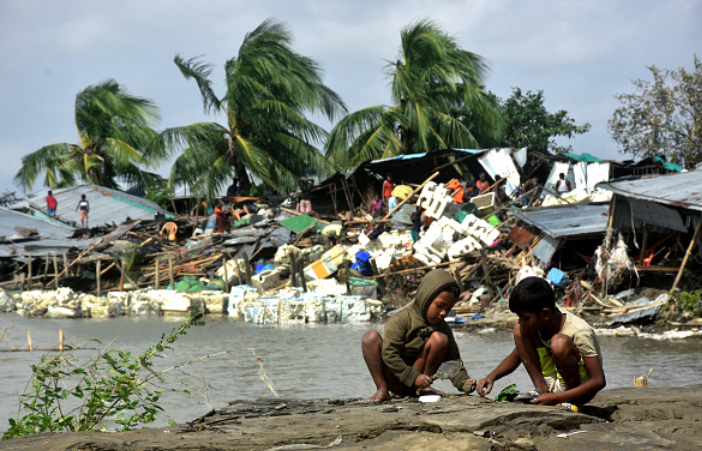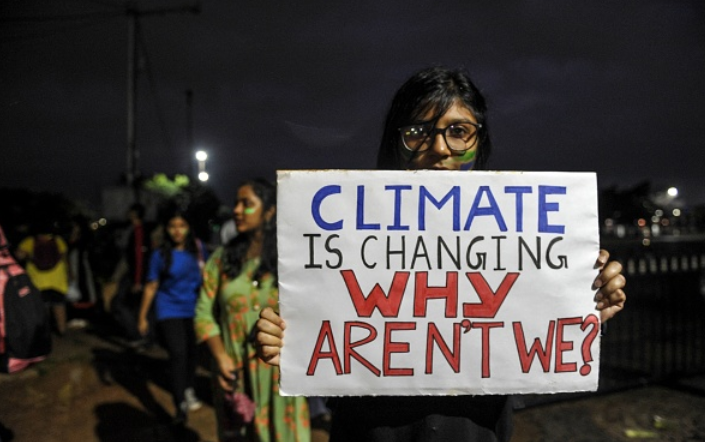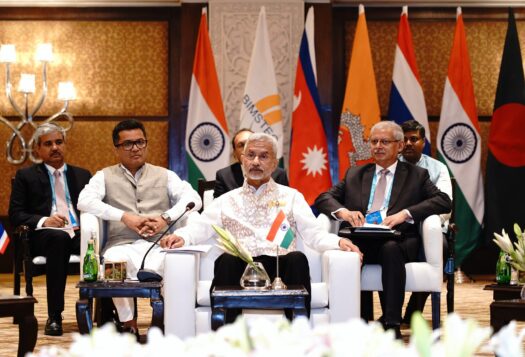
The increasing frequency of extreme weather events in South Asia highlights the region’s climate vulnerability, which significantly affects regional mass displacement. While the catastrophic floods in Pakistan displaced over 7 million people in 2022 alone, a 2018 World Bank study predicts that nearly 40 million people in South Asia could be forced to flee their homes by 2050, owing to a dearth of climate-sensitive policies. Another study from 2020 estimates that the number of displaced people in the region could rise to 63 million by 2050. Although most of South Asia’s climate-induced migration is internal, empirical research has highlighted increased cross-border population movements in response to climate-related risks. For instance, frequent and more intense floods and salinity ingression causing the loss of lands and livelihoods have been observed as important factors in driving migration from Bangladesh to India.
As a key player in the region and a major destination country for climatically displaced persons, India can push for a strong climate displacement paradigm suited for the unique context of South Asia. A state-led consultation forum, with the active involvement of other stakeholders — along the lines of the 2012 Nansen Initiative launched by the Governments of Switzerland and Norway — can prove to be effective in developing and harmonizing regional standards on a number of issues. These include best practices for the admission and stay of the climatically displaced, use of humanitarian assistance mechanisms, mobilization of finances to address climate mobility, long-term solutions for displaced persons, and planning for climate displacement contingencies.
Protection Pathways in the International Legal Regime
International legal instruments do not directly address the movement of people who cross borders in response to or in anticipation of climate-related harms. The 1951 UN Convention Relating to the Status of Refugees, read in conjunction with its 1967 Protocol, warrants protection only for those who suffer a “well-founded fear of being persecuted” on the basis of five criteria: race, religion, nationality, political opinion, or membership of a particular social group. Additionally, the definition limits the scope of protection to individuals outside their country of origin, who are unable or unwilling to seek protection from the government of their own country. Many of those displaced by climate-related impacts do not qualify for recognition under the instruments for the protection of internally displaced persons (IDPs), including the landmark Kampala Convention of 2009 — the first continental treaty aimed at protecting and assisting IDPs. Further, the mechanism of “complementary protection” under international human rights law also does not offer strong guarantees of protection to people who fail to meet the conventional refugee definition.
As a key player in the region and a major destination country for climatically displaced persons, India can push for a strong climate displacement paradigm suited for the unique context of South Asia.
However, the United Nations Human Rights Committee’s 2020 ruling in Ioane Teitiota v. New Zealand opened the doors for future jurisprudential developments and policy reforms. The committee recognized that climate change is indeed a serious threat to a person’s ability to enjoy their right to life by applying the principle of non-refoulement — which provides a safeguard from deportation to a place where the refugee fears a “real risk” or threat to life and freedom. The decision, thus, allowed for the possibility of protection for Teitiota from expulsion to Kiribati, his home country, where sea-level rise had arguably created an “untenable and violent environment”.
A Pluralist Approach to Climate Mobility for Developing a Regional Consensus
In a strictly legal sense, the challenge stems from isolating climate change as the sole cause of a particular instance of displacement. On the one hand, this gives rise to concerns of moral arbitrariness — for example, the difficulty in rationalizing protection for the climatically displaced over other forced migrants escaping risks such as resource scarcity or economic insecurity. On the other hand, this mono-causality attributed to migration also ignores the complexity and contextual variability of climate mobility. The Intergovernmental Panel on Climate Change, in its special 2018 report on “Global Warming of 1.5 °C”, acknowledges that the social, economic, and environmental factors underlying the displacement of people by climate change are complex and varied; therefore, attributing it to the effect of observed climate change is challenging. Additionally, a 2018 study culminating in a set of recommendations for the United Nations High Commissioner for Refugees (UNHCR) on strengthening the refugee law-based international protection regime recognized the role of “nexus dynamics” — a context wherein pre-existing conflict and its resultant social vulnerabilities can aggravate the effects of climate change, or vice versa.

The mainstream discourse on climate mobility is concerned with the concept of climate refugees and, more specifically, with offering recognition to such people as a separate legal entity. This would enable the climatically displaced to seek protection as a matter of right or entitlement — something that is owed to them by the global community. One way of achieving this would be through a legally binding international treaty or convention. However, this one-size-fits-all approach that accords the same status to all climatically displaced persons (without regard to their unique circumstances of displacement) might prove to be inadequate in judiciously meeting the needs of particular communities.
In contrast, a pluralist approach to climate mobility recognizes that different institutions and practices will be appropriate and suited for dealing with different instances of climate displacement, and seeks to develop and reform these particular institutions and practices. For instance, a farming community fleeing their home due to erratic rainfall and droughts can benefit from seasonal labor migration and income diversification policies, whereas a community in a deltaic region threatened by rising sea levels can benefit from immigration and resettlement programs. Notably, cross-border transhumance arrangements, including regional mechanisms which regulate the movement of herders and livestock, are common in West Africa. By adopting the pluralist proposition and harnessing migration as an effective adaptation strategy, South Asia can benefit from a regional consensus for establishing institutional infrastructure and practices to manage climate displacement.
New Delhi’s Chance to Take the Lead
According to the Asian Development Bank, climate change impacts in Bangladesh will likely lead to an increase in both legal and illegal as well as permanent and temporary cross-border migration to India’s neighboring states — mainly West Bengal, Assam, and Tripura. The Sundarbans Delta of Bangladesh, in particular, is a major climate-sensitive hotspot and its inhabitants are vulnerable not only to involuntary migration, but also its knock-on effects such as trafficking and modern slavery. Frequent flooding in Nepal’s Terai Plains bordering the Indian states of Uttar Pradesh and Bihar could also lead to increased movements of the local population across the border to India. Available data shows that “seasonal migration” from Nepal to India — which is crucial for the livelihoods of many Nepalis — may be further exacerbated by climate change. The Maldives and Sri Lanka both face environmental pressures from rising sea levels and that is expected to lead to increased out-migration to India, including to the coastal state of Tamil Nadu across the Palk Strait.
In light of the country’s steadfast refusal to be a signatory to the 1951 Refugee Convention or its 1967 Protocol, the Indian government’s refugee policy consists of a combination of ad-hoc executive decisions and judicial pronouncements. Given the lack of international consensus, a unique opportunity exists for India to address the protection gap in South Asia’s policy regime for climate migrants. It should do this by pushing for an inclusive framework for the protection of the climatically displaced, through institutional reform and well-defined governance standards. The onus rests with India to take the lead in initiating a multilateral dialogue in the region to develop such a system of governance. Broadly, this could entail institutionalizing need-based solutions such as humanitarian visas, planned relocation, and resettlement programs. More importantly, burden-sharing arrangements based on data concerning emerging migration patterns and a fair assessment of state capability can potentially lead to environmental peacebuilding in a region which is ecologically connected but geopolitically fragmented into states with inward nationalizing orientations.
Given the lack of international consensus, a unique opportunity exists for India to address the protection gap in South Asia’s policy regime for climate migrants.
In practice, however, cooperation on issues such as climate displacement often is sacrificed on the altar of geopolitical and traditional security priorities. Against the backdrop of growing anti-outsider sentiment in South Asia and controversial national legislations such as India’s 2019 Citizenship Amendment Act, it is prudent to realize that the success of a regional framework on climate mobility would rely, in part, on its ability to balance its protection obligations for the displaced with the region’s priorities. It is also crucial to acknowledge that although the political will to take any constructive action is lacking at the moment, the political leadership in countries like India arguably seems to benefit from the absence of binding obligations. Therefore, only a region-wide conversation can help South Asia address the issue of climate change and displacement effectively.
Also Read: India at the G20: Prioritizing Climate Finance
Editor’s Note: A version of this piece was originally published on 9DashLine, and has been republished with permission of the editors.
***
Click here to read this article in Urdu.
Image 1: Mohammad Shajahan/Anadolu Agency via Getty Images
Image 2: Noah Seelam/AFP via Getty Images


